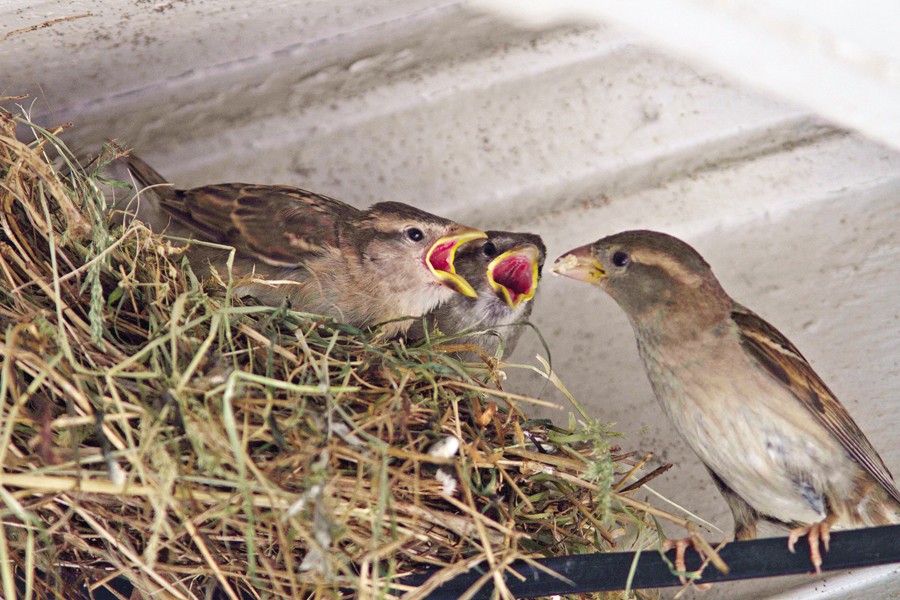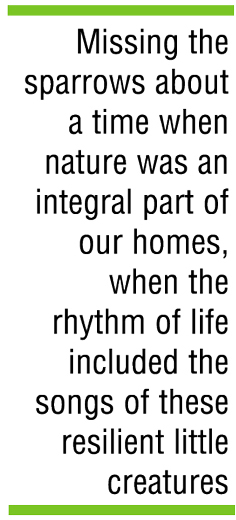
In the heart of Bangladesh, nestled amidst the rhythmic ebb and flow of everyday life, there once thrived a simple, profound symbol of harmony between humans and nature-the humble sparrow. For those who grew up in the 1980s and 1990s, seeing sparrows flitting in and out of ventilators was a common and cherished experience. These tiny birds, chirping and bustling, were not just a part of the environment but a part of the household. Today, however, things have changed radically, and with it, the pervasive presence of sparrows in our lives.
 Traditional Bangladeshi houses were designed with an acute awareness of the natural environment. Ventilators were essential in these homes, allowing fresh air to circulate and provide natural cooling. Ventilators are square or rectangular in shape and designed with different patterns and motifs. These small, high-set openings used to be a sanctuary for sparrows. They nested in these ventilators, finding them a safe home from predators and the elements.
Traditional Bangladeshi houses were designed with an acute awareness of the natural environment. Ventilators were essential in these homes, allowing fresh air to circulate and provide natural cooling. Ventilators are square or rectangular in shape and designed with different patterns and motifs. These small, high-set openings used to be a sanctuary for sparrows. They nested in these ventilators, finding them a safe home from predators and the elements.
There are different species of sparrows, roughly above 40, but those living in house corners are known as the house sparrows. These birds benefited from the safe nesting sites, while their presence added a lively, natural soundtrack to our daily lives. It was not uncommon for families to keep a casual watch on the progress of the baby sparrows, waiting for the day they would take their first flight. The relationship between humans and sparrows was symbiotic.
The 80-90s generation will remember the most famous poem about sparrows by RajanikantaSen-
Says the Sparrow to the Weaver Bird
"Look where I live - a mansion, no less!"
While your nest barely shields you from the wind and the rain.
Yet you prize it as art?
Though we had different perspectives on this poem, it suggests that sparrows build their homes in human mansions.
However, the turn of the century brought significant changes to Bangladesh's architectural landscape. Rapid urbanisation and a shift towards modern living led to the expansion of apartment buildings, which were designed without traditional elements like ventilators, as air conditioners took over the responsibility of cooling.
While bringing comfort and efficiency, this transformation also led to the disappearance of sparrows from our immediate environment. Smooth, unbroken walls replaced the nooks and crannies where they once nested. The chirping that once greeted us in the mornings and evenings faded away. It left behind an emptiness many might not have noticed initially but has become glaringly obvious in retrospect.
"When I was a child, my mother taught me that households where sparrows live are blessed by the angels of Allah," said Mohammad Saiful Islam, a journalist from Dhaka. "So we, the siblings, never did anything that might harm that bird. Those little, innocent lives used to mesmerise us every day."
This shift has been a source of nostalgia and sorrow for those who grew up in the '80s and '90s, an era of ventilator-dwelling sparrows. The sight and sound of sparrows are linked with their childhood memories. The sparrows were not just birds; they symbolised a simpler time, a living connection to the rhythms of nature that once extended throughout everyday life. Watching sparrows feed their young, hearing their morning songs, and even the occasional inconvenience of cleaning up after them were part and parcel of daily life.
Now, the absence of sparrows is felt keenly by many who remember the joy these birds brought to their childhoods. Reminiscing about the memory, MeherunNahar, a Dhaka University student, shared, "In our Dinajpur house, two sparrows lived with their families in two of our ventilators for months. Every morning, when I got up, I would run to check if they were there or had already left. Now, being a zoology student and knowing about birds, I feel their necessity more and more."
Adnan Mohammad, a pet lover, said, "The sparrows were a reminder of the coexistence of humans and wildlife within urban settings. Their disappearance signifies a loss of this harmonious relationship and underscores the environmental impact of rapid urbanisation."
The decline in sparrow populations is not just a sentimental issue but an environmental concern. Sparrows play a crucial role in the ecosystem, controlling insect populations and contributing to soil aeration. Its disappearance might jeopardise the ecological balance. In many parts of the world, sparrows are considered bio-indicators, and their presence or absence reflects the environment's health.
There is a growing awareness and a sense of urgency to bring back the sparrows. Urban planning that includes green spaces, the installation of bird feeders, and the incorporation of natural habitats in architectural designs are ways to encourage these birds' return. Since 2010, March 20 has been celebrated as 'World Sparrow Day,' initiated by an Indian organisation, The Nature Forever Society, stressing the significance of saving house sparrows and other usual birds.
For individual households, small steps can make a big difference. Installing birdhouses, creating gardens, and avoiding the use of pesticides can create a more welcoming environment for sparrows and other small birds.
Missing the sparrows in our ventilators is not just about the birds themselves but about the essence of what they represented - a time when nature was an integral part of our homes, when the rhythm of life included the songs of these resilient little creatures. It's a call to rekindle that bond, to ensure that future generations also have the joy of waking up to the cheerful chirping of sparrows, and to remember that in our quest for modernity, we should not lose sight of the simple pleasures that connect us to the natural world.
afranawmi@yahoo.com
© 2025 - All Rights with The Financial Express
